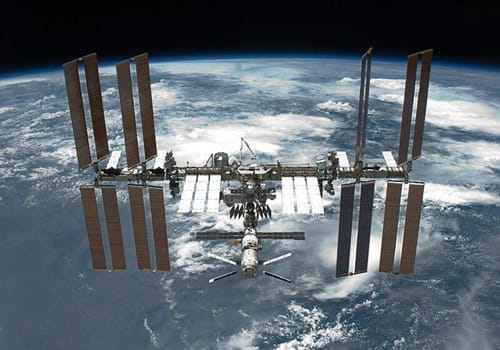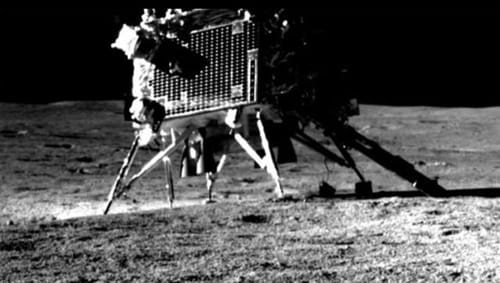-Natstrat.jpg)
The crew members of the first-ever two-nation cooperative space mission, known in the US as the Apollo-Soyuz Test Project (ASTP) and in the Soviet Union as the Soyuz-Apollo Experimental Flight, 1975.
For years, states like India have maintained a deliberate distance from the great power rivalries unfolding in the space domain. Since its inception, India's investment in space technologies has been primarily directed towards socio economic development, an agenda that persists to this day. Presently, India is actively expanding its private space sector to bolster the space economy. Concurrently, India is also leveraging space technologies to bolster its armed forces' capabilities.
Introduction
The author of the renowned political allegory "Animal Farm," George Orwell (1903-1950), is credited with coining the term ‘Cold War’ in one of his articles published in 1945. Orwell’s essay, titled “You and the Atomic Bomb,” appeared less than three months after the bombings of Hiroshima and Nagasaki. In it, he foresaw a future where two to three superstates possessing nuclear weapons could annihilate millions within seconds.
In the aftermath of World War II, it became evident that the United States (US) and the Soviet Union would emerge as the two primary power blocs shaping global geopolitics. This nuclear standoff extended into space, exemplified by the Soviet Union's historic launch of the world's first artificial satellite, Sputnik, in 1957. Remarkably, space has since evolved into both a realm of collaboration and competition among major powers.
The Cold War Years
During the initial phase of the Cold War, both superpowers were engaged in assessing each other's capabilities in space. Following the launch of Sputnik, the US swiftly responded by launching their first satellite within a few months. However, the true awakening for US political and scientific circles came with Soviet Cosmonaut Yuri Gagarin's successful journey to space and back in 1961. This realization underscored the US perception of lagging behind the Soviets in the technological race.
In response, the US embarked on a monumental project: sending a man to the Moon. This endeavour served as a technology demonstration with the explicit aim of showcasing their superiority over the Soviets in technological prowess. The culmination of this effort came in 1969 with the historic landing of Apollo 11 on the Moon, and Neil Armstrong's iconic first steps on its surface. Interestingly, before the Moon mission was meant to demonstrate the technological prowess of the US, both the states had started engaging each other during 1962 amid the Cuban Missile Crisis.
During that period, the focus was on cooperation on the exchange of data from weather satellites and conduct of some scientific studies.
Interestingly, President Kennedy was keen for a joint Moon landing and was in talks with Nikita Khrushchev. But the political leadership landscape in both the states changed with the assassination of Kennedy (1963) and removal of Khrushchev (1964). Subsequently, when the culmination to the Vietnam War became evident, space agencies from both the states started engaging each other. This led to the famous Apollo–Soyuz handshake in space in July 1975.
As these powers started making investments in the space domain, there was a realization that space technologies have much utility in the fields beyond military. By 1967, the Outer Space Treaty (OST) became a reality which prohibits states from placing Weapons of Mass Destruction (WMDs) and undertaking any WMD tests in space. The space domain has been an important element in various arms control and disarmament measures undertaken around the period of 1960s-1970s. In addition, the conclusion of the Nuclear Non-Proliferation Treaty (NPT) required the US and Soviet Union to negotiate nuclear disarmament, and the development of satellites made it possible to verify compliance.
The US and the Soviets agreed bilaterally during the Strategic Arms Limitation Talks (SALT I, 1972) that they would not disturb the function of satellites used for verifying compliance. In the year 1972, the US and the Soviets signed the Agreement Concerning Cooperation in the Exploration and Use of Outer Space for Peaceful Purposes, commonly known as the “Civil Space Agreement.” This enabled the expansion of cooperation into other areas, including space science, Earth science, satellite-based search & rescue, and, later, human space flight. Russian-made instruments were incorporated as a part of some of National Aeronautics and Space Administration’s (NASA) robotic probes to the Moon and Mars. NASA has had a prolonged partnership with Soviet and Russian space scientists in Mars exploration since the 1980s.
Apart from these two power blocs other states in the world also realised that space technologies are the game-changer in both civilian and military domains with numerous applications for peaceful purposes as well as military uses. Particularly, a few Asian states decided to establish their own space programmes. China and Japan became spacefaring states by 1970 and a decade later India became a spacefaring state as well.
During the Cold War period, there was intense competition and confrontation between the US and Soviets across various strategic fields, including space. However, it could be argued that space was one domain where visible collaboration also occurred. Following the end of the Cold War, space exploration shifted towards collaborative endeavours. The Shuttle–Mir program, spanning from 1993 to 1998, exemplified this shift, entailing visits by US space shuttles to the Russian space station Mir. Subsequently, these two powers emerged as major contributors to the establishment of the International Space Station (ISS), whose assembly commenced in November 1998. The ISS represents a multinational effort, with participation from the space agencies of the US, Russia, Japan, Canada, and 11 member states of the European Space Agency (ESA).

The International Space Station, 2011.
Despite the shadow cast by the 2014 Ukraine crisis and the subsequent annexation of Crimea, the Russian Federal Space Agency, Roscosmos, and NASA had continued to collaborate. Following the conclusion of the US Space Shuttle program in 2010, NASA relied entirely on Soyuz spacecraft for transportation of their astronauts to the International Space Station (ISS). This partnership has persisted even amid the ongoing conflict in Ukraine.
Notably, the US military places significant importance on the Atlas-V rocket for specific launches. For many years, the US relied on Russia for the supply of RD-180 rocket engines necessary for these launches. Remarkably, even during times of political crisis, this supply remained uninterrupted.
China and Great Power Rivalry in Space
In recent decades, China has emerged as a significant player in the space domain, achieving milestones such as establishing their own space station and fostering vibrant Moon and Mars exploration programs. Notably, China has successfully conducted sample return missions from the Moon and has forged strong partnerships with Russia, collaborating on various joint space initiatives. However, it is worth noting that NASA's engagement with China has been restricted since 2011-2012, in accordance with the Wolf Amendment.
In today's space domain, the great power competition primarily involves three major players: the US, Russia, and China. The historical closeness between the US and Russia, albeit intermittent, is rapidly waning due to growing concerns over space weaponization and the aggressive development of counter-space programs by both Russia and China.
These concerns are underscored by instances of debris-generating anti-satellite tests (ASAT) conducted by Russia and China in 2007 and 2021. Recent reports suggest that Russia may be pursuing the development of an ASAT nuclear weapon and could have already deployed a co-orbital weapon in space. Unfortunately, instead of fostering cooperation, all three states are engaging in political manoeuvring, hindering any multilateral or UN-supported discussions on space security. This rivalry not only exacerbates tensions among the major spacefaring nations but also poses a significant threat to space security for all stakeholders involved.
During the Cold War and for about a decade thereafter, the geopolitical competition in the space domain largely revolved around technological supremacy and national prestige. This dynamic was not devoid of the looming spectre of nuclear weapons and missile capabilities. However, in the 21st century, space has unmistakably become both a figurative and literal battlefield.
In this evolving landscape, the coexistence of competition and collaboration, as witnessed in the past, appears increasingly untenable. The strategic choices made by states will determine their trajectory in the space domain, reflecting their calculations of power and security concerns.
India’s Approach to Space

Chandrayaan-3 lander on the lunar surface, 2023.
For years, states like India have maintained a deliberate distance from the great power rivalries unfolding in the space domain. Since its inception, India's investment in space technologies has been primarily directed towards socio-economic development, an agenda that persists to this day. Presently, India is actively expanding its private space sector to bolster the space economy. Concurrently, India is also leveraging space technologies to bolster the capabilities of its Armed Forces.
India remains steadfastly opposed to the weaponization of space, a policy that endures. However, due to unique security challenges—such as sharing borders with two nuclear powers, one of whom possesses ASAT capabilities, and historical unresolved boundary disputes—India conducted an ASAT test in 2019 (majorly avoided any debris creation). India perceives counter-space technologies as a vital component of its deterrence strategy.
India's space programme is built upon four key pillars: fostering social and economic growth, advancing scientific development, meeting strategic needs, and maintaining indigenous origins. India’s collaborations with major space powers are carefully crafted to support growth in social, commercial, and scientific domains. India maintains a stance of neutrality in the great powers' space rivalries, instead prioritizing cooperation for mutual benefit.
Moreover, India regards the Moon and other celestial bodies as integral to global commons. India is advocating for a rule-based and legally binding framework for global space governance. This approach underscores India's commitment to responsible and inclusive participation in the exploration of space.
(Exclusive to NatStrat)